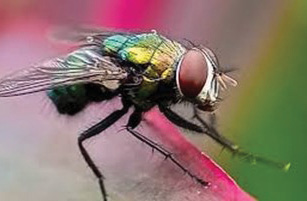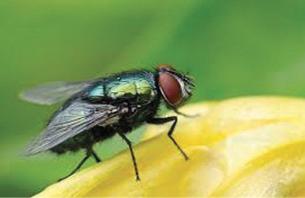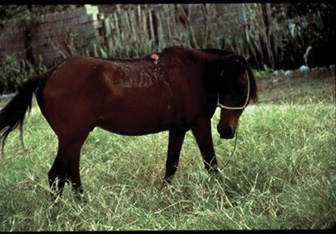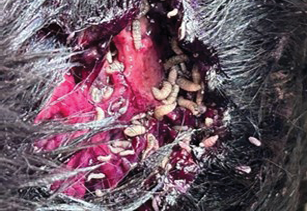Guide B-115
Marcy Ward
College of Agricultural, Consumer and Environmental Sciences, New Mexico State University
Author: Extension Livestock Specialist, Extension Animal Sciences and Natural Resources, New Mexico State University. (Print Friendly PDF)
Recent News
The United States Department of Agriculture has halted animal imports from Mexico as of May 11, 2025, after new cases were found in two Mexican states: Oaxaca and Veracruz. Because of the proximity to the United States, these measures are meant to protect our country’s food supply and livestock. Here’s what to look for around your livestock and pets.
What is the New World Screwworm?
The New World Screwworm is a type of fly that can seriously harm animals (Figure 1). It looks like an ordinary housefly (Figure 2), but it’s far more dangerous. Here’s why:
- The fly lays its eggs in open wounds or openings of an animal’s body (Figure 3).
- When the eggs hatch, the larvae feed on the animal’s living flesh (Figure 4).
- A single female fly can lay up to 3,000 eggs.
- These flies can live for 10 to 30 days and travel as far as 15 miles.




Figure 4. Open wound infested with NWS larvae.
Why It’s a Problem
The larvae are the real threat—they make wounds much worse and can cause severe infections. All warm-blooded animals (including livestock, pets, and even humans) can be affected. If an infected animal isn’t treated, it can suffer greatly and may even die from infection, starvation, or dehydration.
What’s the Risk?
Right now, the chance of New World Screwworm entering the U.S. is of concern. The biggest risk comes from infected animals or wildlife crossing the border with larvae already in their wounds.
Bottom Line
The USDA’s quick action helps keep this dangerous pest out of the U.S. and protects both animals and the people who depend on them. Producers and exhibitors should be aware of New World Screwworm, help keep a close eye on livestock and pets, and know how to report it.
What to do if you suspect New World Screwworm
Take photos of wounds and consult a veterinarian. Remove all the larvae, clean the wound, and isolate the animal. Samples can be sent for analysis. Contact the New Mexico Department of Agriculture Veterinary Diagnostic Services (505-383-9299) or your local Extension office (https://extension.nmsu.edu/county.html) for sample submission guidance.
Sample Preparation:
- With forceps, gently remove larvae of different sizes from several sites of the wound (ensure samples are also removed from the deepest tissue of the wound).
- Place larvae in a leak-proof container/vial, fully submerged in 70% alcohol (ethanol or isopropyl).
- Label the vial(s) with animal ID, date/time of collection, location, and collector’s name.
- Seal the vial/container and place it in a sealable plastic bag. Place this bag into another sealable plastic bag.
This is a reportable disease, therefore, the New Mexico Livestock Board should be contacted at (505) 841-6161 or (505) 414-281. A reporting form can be found at https://survey123.arcgis.com/share/cc8cfa0827f84faaa553b85f1756c090.
Prevention:
- Establish a good parasite control (anthelmintic) program for your livestock.
- Consult with your veterinarian for ideal products for each species. Longer acting, injectable anthelmintic products are recommended.
- Be aware of withdrawal times.
- It is critical to read the product labels.
- Surveillance is key. Watch for open lesions that do not appear to be healing and have presence of maggot activity.
- Animals in confinement:
- Perimeter fly control is your first line of defense. Pyrethrins work well.
- Good manure management will reduce fly attraction and production.
This USDA’s Animal and Plant Health Inspection Service brochure contains additional information on the New World Screwworm, including life cycle, distribution, and identification: https://www.aphis.usda.gov/sites/default/files/screwworm-poster.pdf.

To find more resources for your business, home, or family, visit the College of Agricultural, Consumer and Environmental Sciences on the World Wide Web at pubs.nmsu.edu.
Contents of publications may be freely reproduced, with an appropriate citation, for educational purposes. All other rights reserved. For permission to use publications for other purposes, contact pubs@nmsu.edu or the authors listed on the publication.
New Mexico State University is an equal opportunity employer and educator. NMSU and the U.S. Department of Agriculture cooperating.
June 2025 Las Cruces, NM


